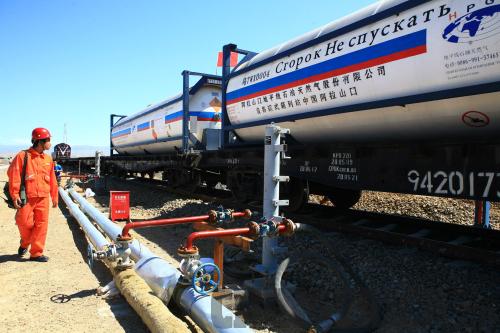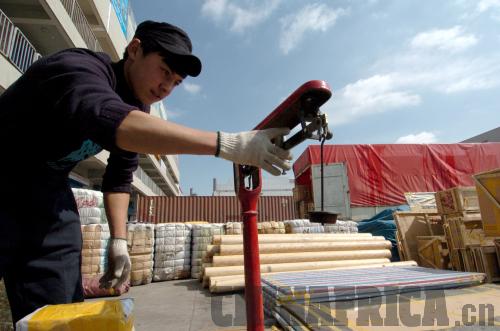|
 |
|
FAST FLOWING: Gas is transported by rail on the new Silk Road |
Local opinion is divided as to what the International Convention and Exhibition Center in northwest China's Urumqi most resembles. Some say it's a UFO; some say the bridge of an aircraft carrier, while others reckon it to be a giant piece of naan bread, the local dietary staple in multiethnic Xinjiang Uygur Autonomous Region, of which Urumqi is capital.
Whatever it looks like, there's no doubt the center is an impressive structure. Purpose built last year to host the first annual China-Eurasia Expo, September 2-7 this year saw the crowds return to the center for the second installment of the event, billed as a key gathering of political and business leaders from China, Central Asia and beyond.
At the expo's opening ceremony on September 2, a key theme was reviving the Silk Road, the interlinking network of trade routes that once laced its way from east China to North Africa and Europe.
Geographical disadvantage
Where camels once dominated, it is horsepower, tarmac and railways that are smoothing the way for the 21st century incarnation of the Silk Road. And in good time, too.
"Logistics and the lack of logistics in many parts of the world has become the largest non-tariff barrier to the growth of trade," said Babar Badat, Vice Chairman of the International Federation of Freight Forwarders Associations, at a forum on logistics held during the expo.
"In the 20th century, inadequate logistics infrastructure was especially acute in Central Asia, which, when Pakistan and Xinjiang are included, is home to some 250 million people," Badat noted.
Shipping is involved in 90 percent of international trade, and it was the rise of cheap, reliable shipping that led to the demise of the original Silk Road. For landlocked Central Asia, the cost of sending goods more than 1,000 km overland to the nearest ports rendered the area irrelevant to the development of international freight transport.
Lack of access to shipping is particularly pronounced in Xinjiang, the furthest point in all of Eurasia from a coastline.
After the Shanghai Cooperation Organization (SCO) was founded in 2001, SCO member states, which now include China, Kazakhstan, Kyrgyzstan, Russia, Tajikistan and Uzbekistan, soon realized that their geography was an advantage - improving road and rail linkages between them could mean reducing transit times for freight sent anywhere between the Far East and Europe by up to half. The idea of a new Silk Road was born.
"Shipping still accounts for 95 percent of the China-Europe goods trade. In the next few years we hope to raise the proportion of overland freight transport to 10 percent," said Albertas Aruna, Secretary of the East-West Transport Corridor Association.
To date, most China-Europe overland freight has been carried on trucks. But this is changing as rail infrastructure in Xinjiang and China's central Asian neighbors rapidly improves.
The year 2008 saw the first test shuttle train, owned by German state-owned railway company Deutsche Bahn (DB), depart from Beijing to Hamburg in Germany. The train traveled along the Trans-Siberian arterial line and reached its destination 10,000 km away in 20 days, twice as fast as the sea route.
In 2011, DB changed tack and started employing the Xinjiang-Kazakhstan connection for its China-Europe overland freight. In April last year, it initiated a Chongqing-Duisburg route, which passes through Xinjiang, Russia, Belarus and Poland. The first train took 15 days to complete the 11,179 km. A regular Chongqing-Duisburg service kicked off shortly after, which now runs daily. Twice-daily departures are planned for 2013.
This year the Saule shuttle train has joined the DB train in providing a regular rail freight service from China to Europe. Run by VPA logistics, a Lithuanian company, the train departs from Chongqing for Europe's biggest port in Belgium's Antwerpen.
 |
|
OVERLAND FREIGHT: The new Silk Road allows companies to transport construction materials over land |
Smoothing rail freight
These "Silk Railroad" pioneers are inspiring, but there are still kinks to be ironed out if rail is to reach its full potential, said Ji Yuwei, head of the transportation department at the United Nations Economic and Social Commission for Asia and the Pacific.
"We need to simplify customs procedures further, come to a common agreement on taxes, charges and insurance, and introduce electronic tagging of wagons as de rigueur along the China-Europe route," Ji said.
At the China-Eurasia Expo, Chinese business representatives seemed cautiously optimistic about the prospects for this new Silk Road.
"Currently only 10 percent of our business is rail freight, most of which ends up in Central Asia," said You Zhengrong, Deputy Manager of Lianyungang Far-Famed International Freight Agency, based in Jiangsu Province.
"I suppose we would be interested in sending some goods to Europe by train," You said. "But we mostly deal in construction goods freight - time isn't a critical factor in transport. Shipping is slower, but it's cheaper. This new Silk Road sounds good, but at the end of the day it's all about cost." |